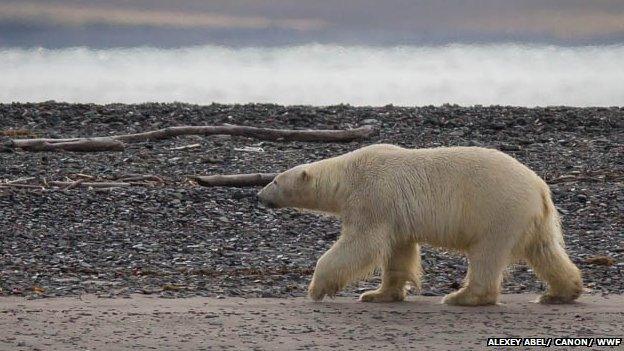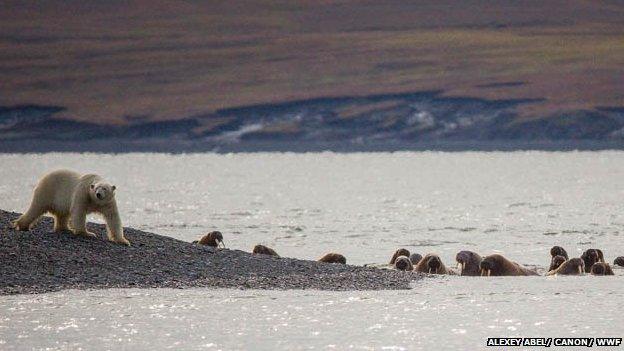Russia's Arctic: Polar bears
- Published

Polar bear at Cape Tsvetkov: The lack of ice is pushing them onto land more often
There are estimated to be between 20,000 and 25,000 polar bears globally.
The bear population is thought to have increased after the 1973 Agreement for the Conservation of Polar Bears, external. But scientists believe they are now in decline again in some areas due to climate change.
The polar bear is the biggest bear. It weighs up to 800kg (1,763 pounds) and when it stands on its hind legs it is more than four metres (13ft) tall. They can run at up to 50km/h (31mph) for short distances on land, and have been known to swim for up to 600km (372 miles) when there is no ice.
They mostly eat ringed seals, but will prey on many marine mammals including walrus and even beluga whale. They will also eat fish.
Icy habitat
They are most comfortable on sea ice, where they can more easily catch seals. But with the extent of the sea ice in the Arctic Ocean shrinking dramatically - and the ice getting thinner - polar bears are having to spend more time on land in the summer.
For example, more and more are turning up in Iceland each year, where many of them are simply shot.
On-shore and near-shore drilling for oil and gas in the Arctic in Alaska does not seem to have affected polar bears significantly. But nobody knows what effect the wholesale development of the Arctic will have.
Experiments in Canada in the 1960s showed that bears covered in oil licked it off and died.
If the bears' sources of food, like the ringed seal, get displaced by oil and gas rigs - or by an increase in shipping - then they could struggle to feed, and that may cause a further decrease in numbers.

Bears prey on marine mammals, but increasingly they risk being hunted by humans on land
Impact of drilling
The lack of preparation for protecting polar bears when Arctic drilling increases is worrying conservationists.
"What's the plan? There isn't a plan. Nobody has the equipment or the training to cope with it," said Geoff York of the environmental group WWF.
Many female polar bears come ashore to make dens in November and December to have their young, and the numbers doing so are increasing, presumably because of the changes in the sea ice.
The usually make their dens in deep drifts of snow. As the climate changes there are starting to be problems with dens collapsing with earlier than usual spring rain.
Polar bears in Russia live all along the Arctic coast from Murmansk in the west to Chukotka in the east, including in the areas where oil and gas development are most likely - the Barents Sea, South Kara Sea, Laptev Sea and Chukchi Sea.
Wrangel Island off Chukotka - which was the first protected area in Russia specifically for polar bears - is surrounded by sea earmarked for oil and gas development.
There is a problem with polar bear poaching in Russia, and there is a risk that as more come ashore - and as more people work in the Arctic - the numbers of bears being hunted will increase.
In the 1973 agreement all the Arctic nations with polar bears agreed to protect the bear's habitat, but at that time nobody thought that the biggest threat of all to the habitat would be climate change. The ice the bears live on is simply disappearing.